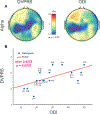Identifying and Engaging Neuronal Oscillations by Transcranial Alternating Current Stimulation in Patients With Chronic Low Back Pain: A Randomized, Crossover, Double-Blind, Sham-Controlled Pilot Study
- PMID: 30268803
- PMCID: PMC6382517
- DOI: 10.1016/j.jpain.2018.09.004
Identifying and Engaging Neuronal Oscillations by Transcranial Alternating Current Stimulation in Patients With Chronic Low Back Pain: A Randomized, Crossover, Double-Blind, Sham-Controlled Pilot Study
Abstract
Chronic pain is associated with maladaptive reorganization of the central nervous system. Recent studies have suggested that disorganization of large-scale electrical brain activity patterns, such as neuronal network oscillations in the thalamocortical system, plays a key role in the pathophysiology of chronic pain. Yet, little is known about whether and how such network pathologies can be targeted with noninvasive brain stimulation as a nonpharmacological treatment option. We hypothesized that alpha oscillations, a prominent thalamocortical activity pattern in the human brain, are impaired in chronic pain and can be modulated with transcranial alternating current stimulation (tACS). We performed a randomized, crossover, double-blind, sham-controlled study in patients with chronic low back pain (CLBP) to investigate how alpha oscillations relate to pain symptoms for target identification and whether tACS can engage this target and thereby induce pain relief. We used high-density electroencephalography to measure alpha oscillations and found that the oscillation strength in the somatosensory region at baseline before stimulation was negatively correlated with pain symptoms. Stimulation with alpha-tACS compared to sham (placebo) stimulation significantly enhanced alpha oscillations in the somatosensory region. The stimulation-induced increase of alpha oscillations in the somatosensory region was correlated with pain relief. Given these findings of successful target identification and engagement, we propose that modulating alpha oscillations with tACS may represent a target-specific, nonpharmacological treatment approach for CLBP. This trial has been registered in ClinicalTrials.gov (NCT03243084). PERSPECTIVE: This study suggests that a rational design of transcranial alternating current stimulation, which is target identification, engagement, and validation, could be a nonpharmacological treatment approach for patients with CLBP.
Keywords: Chronic low back pain; alpha oscillations; electroencephalography; transcranial alternating current stimulation.
Copyright © 2018 the American Pain Society. Published by Elsevier Inc. All rights reserved.
Figures





References
-
- Ahn S, Ahn M, Cho H, Chan Jun S: Achieving a hybrid brain–computer interface with tactile selective attention and motor imagery. J Neural Eng 11:066004, 2014. - PubMed
-
- André-Obadia N, Peyron R, Mertens P, Mauguière F, Laurent B, Garcia-Larrea L: Transcranial magnetic stimulation for pain control. Double-blind study of different frequencies against placebo, and correlation with motor cortex stimulation efficacy. Clin Neurophysiol 117:1536–44, 2006. - PubMed
-
- Arendsen LJ, Hugh-Jones S, Lloyd DM: Transcranial Alternating Current Stimulation at Alpha Frequency Reduces Pain When the Intensity of Pain is Uncertain. J Pain, 2018. - PubMed
-
- Benjamini Y, Hochberg Y: Controlling the False Discovery Rate: A Practical and Powerful Approach to Multiple Testing. J R Stat Soc Ser B 57:289–300, 1995.
Publication types
MeSH terms
Substances
Associated data
Grants and funding
LinkOut - more resources
Full Text Sources
Other Literature Sources
Medical

